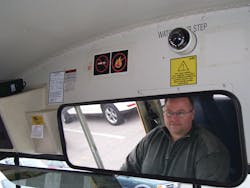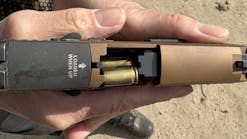In January 2012, a fire started just south of Reno in Nevada’s Washoe County. Here’s a look at the Washoe Drive Fire according to the numbers:
- 421,407: population of Washoe County
- 3,177: acres burned
- 29: homes destroyed
- 5: minutes it took to evacuate the students
Even with a fire making its destructive way towards them, the staff and students did not fall into chaos. Instead, the evacuation was a smooth reenactment of prior practice. “We have a small elementary school of 300 students in the middle of this community,” states Mike Mieras, Chief of Police, Washoe County School District Police. “Because we had been through all the drills, the school staff and our officers, we were able to evacuate that school in five minutes. That includes getting the kids on the buses and out of the area in five minutes. It pays off to have these measures in place.” These measures were funded in part by the Secure our Schools (SOS) grant issued by the Community Oriented Policing Service (COPS) office of the U.S. Department of Justice (DOJ).
About the SOS
The COPS office states that “America’s children spend more time in school than almost any other place outside the home.” Due to this, school safety requires more than just diligent teachers but necessitates the assistance of administration, security staff and law enforcement. Demonstrating its commitment, the COPS office has funded more than $913 million in grants through a variety of programs, including the SOS grant.
In 2009, the COPS office funded $16 million to 128 agencies in 38 states. In 2010, they offered $15.9 million to 167 agencies in 40 states and Puerto Rico and in 2011, 93 agencies in 32 states received $13 million. The SOS grant gives up to $500,000 to help with project costs related to school security and safety. These can include metal detectors, locks, lighting, fencing, closed-circuit surveillance systems, security assessments and security training. Grant funding requires a 50% match and although the money is for school district projects, the local law enforcement agency must be the applicant. This combination encourages partnerships from the very beginning. What makes this grant interesting is the variety of ways agencies are using the money to fit their unique needs.
Olathe, Kan.
Olathe Police Department applied for SOS funding in 2005, and in each year 2007 through 2010. Olathe Unified School District has just over 28,000 students with a local population of 127,022. The department was awarded $17,750 in 2005 and $68,750 in 2010. When Olathe PD heard about the grant opportunity, they called the school district and asked if they would like to apply. The department already had a School Resource Officer (SRO) program in the district including ten full-time SROs (one with a K-9) and a full-time supervisor. The grant seemed like a good fit for current priorities in light of the changes needed to meet federal regulations.
Each of Olathe’s SOS grants was used for a different project. The first grant was used for a community notification system. The second is being used to implement 700 MHz radios. “The safety assessment (a requirement for every SOS grantee) indicated a pending loss of crisis management communications during critical incidents for the school district with the Federal mandate to move to a P25 compliant, 700 MHz radio system,” explains Jeri K. Graniewski, Administrative Division Manager, Olathe Police Department. “The Johnson County radio system that the school district is currently working under will no longer be available with the upgrade to the 700 MHz system. To maintain interagency operability, the school district needs to move to the P25 compliant 700 MHz radio system by 2013.” With the new radio system, the district and police can work together communicating to keep the students safe.
Henry County, Ken.
Due to the predominately rural demographics of Henry County, the sheriffs office requested SOS grant funding with a different vision. The Henry County Sheriffs Office received SOS grants for numerous years, including 2009, 2010 and 2011. “The original (COPS) grant was to place an SRO in the district,” explains Denise Perry, Director of Student Services, Henry County Public Schools. The district contains five schools with a student population of 22,000. “One of the big things we’ve used the money for is digital monitoring equipment for the school buses,” explains Perry. “That was the first (SOS) grant we wrote. We started putting VCR systems on the buses.” The district has a large sparsely populated geography. Kids from all grade levels ride the same buses and some students have an hour and a half ride each way per day. The district runs 26 bus routes with over 2,500 miles each school day.
Safety on the roads for the general public and safety and security of the students is what Henry County hopes to accomplish with their grant money. Although they only received a small grant ($11, 045 in 2010 and $6, 970 in 2011) in comparison to the maximum amount, Henry County has done a lot with it, putting in secure entry systems in the middle and elementary schools, installing an emergency notification system, as well as, placing video systems at the high school and middle school campus. “The high school is the primary large venue for any community event so it helps because the sheriffs office is responsible for law enforcement there during school hours and out of school events,” explains Perry.
Washoe County, N.V.
In another variation for SOS funding, Washoe County not only used their grant funding for the training which helped out in the fire, but also for a variety of other security and safety advances. “This is our second one,” states Mieras. “Our original one (was) to put cameras in our high schools and middle schools. We put in for another one to secure the perimeter and to change out some of the old out-dated locks in the schools.” In 2011, they received the maximum amount with a grant for $500,000. Washoe County’s relationship with the school district began way before the SOS funding. “I put in a grant six years ago through the Department of Education,” states Mieras. “We got almost a million for emergency management and that funding didn’t last very long, so we looked into additional funding because when we went into the schools we realized there were a lot of other things we need funding for.” The district has 112 K-12 schools with a student population of 65,000. The main focus of the 2011 grant is to replace the interior locks. “We have older locks,” explains Mieras. “If we have a lock-down situation or worse case scenario an active assailant, the teachers currently would have to step out into the hallway, the danger zone, to lock the door. With this new grant, they can lock from inside the classroom.”
Springfield, Ore.
Springfield hosts a population of around 68,000 students with half living below the poverty line. A local high school, Thurston was also the scene of a tragic school shooting in 1998. “When we got our first Secure our Schools grant, it helped with some security work out at Thurston High School,” explains Michael E. Harman, Services Bureau Manager, Springfield Police Department. “They had the teachers, staff, parents, facility and maintenance staff just kind of walk around and give their perspective on what was necessary and what would work the best and kind of through that whole process they developed a security template and then applied that to the different schools.” So in 2009, they received $75, 505 in SOS funding to bring the middle schools to the standards and in 2010, they received $94,402 to bring the elementary schools up. “The middle school grant is finished,” states Harman. “The elementary school is a work in progress.”
The ability to adjust the grant was an important piece to Springfield due to city decisions to close several schools and change the grade level of another. “We are in the process right now of doing a grant adjustment with the COPS office so that we’ll pull the funding at the (closed) schools and reallocate it at the other projects,” explains Harman. “The grant adjustment is usually pretty simple. The COPS office is usually really good and has pleasant people to work with.”
In the elementary schools and the middle schools, the district put in building and remote monitoring of the campuses. Another technological improvement was the implementation of a card access system which allows greater control. “If you’re a custodian, your card works when it needs to work,” explains Harman. “”If you’re a teacher, you have a card and whatever schools you’re assigned to your card is programmed for them. If you change schools, you don’t have to remember to get your key.” It also prevents the district from having to re-key all the doors if someone is not suppose to have access anymore. “With a card lock system, if a card is lost, you just go into the computer and deactivate that card and it doesn’t work anymore,” explains Harman. “It’s cost effective. It’s fast. These are all things for the district.”
On a police department level, technological advances have been made as well by the implementation of an emergency lock-down button. A single button at a manned work station allows staff to remotely lock all the doors and alert the teachers of a problem. “Whenever we have a dangerous situation, we notify dispatch and they notify the front counter and they can lock the doors and wait for us to give an all clear,” states Harman. “So for the police department, as a partner in keeping the kids safe that’s a tremendous advantage for us to have.”
Stretch the dollars
The biggest advantage to the SOS grant is the ability for school districts and police departments to make local funding go further. “It’s gotten us equipment that we couldn’t have afforded otherwise,” states Perry. “It’s helped us crystallize and focus on the needs. When you go through the process of writing a grant, you look at the safety concerns and it gives you a way to focus your thoughts and needs.” Many agencies met the 50% match with local funds and the grants allowed them to double their money. “They said they had already planned to do a limited amount of security work at some of the schools but if we got COPS grant funding we could actually finish some projects rather than cut corners on them,” says Harman. Unfortunately, not every department can meet the match. In fact, Olathe did not apply in 2011 because they could not afford to.
Partnerships
Another benefit to the SOS grant is the partnership opportunity between the district and the local law enforcement agency. “There is a collaborative effort,” states Graniewski. “The grant is for the school district but without them having 700 MHz radios, we can’t communicate very well with them. We already have a strong relationship with the district. Being able to communicate very rapidly is the key.” The video equipment set up in Henry County schools has been helpful for law enforcement investigations. “Our goal is to promote an ongoing relationship with the school,” explains Harman. “We want to be good partners with them. We want good communication and quick access to the facilities and we’re well on our way to doing that.”
Even with the difficult match requirement, many agencies applaud the COPS office for assisting with improved safety and security in schools. Perry explains how the grant acted as the seed money for many of their projects but the agency was able to maintain and improve on the technology after the initial funding ran out. Partnerships are strengthened and local funds go further in a time when money is particularly tight for districts and law enforcement. “We feel that the schools are as safe as they can be,” explains Perry. “Anything that is an issue in the community is an issue in the schools and anything in the schools becomes a community issue.”

Michelle Perin
Michelle Perin has been a freelance writer since 2000. In December 2010, she earned her Master’s degree in Criminology and Criminal Justice from Indiana State University.



